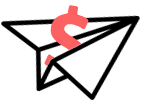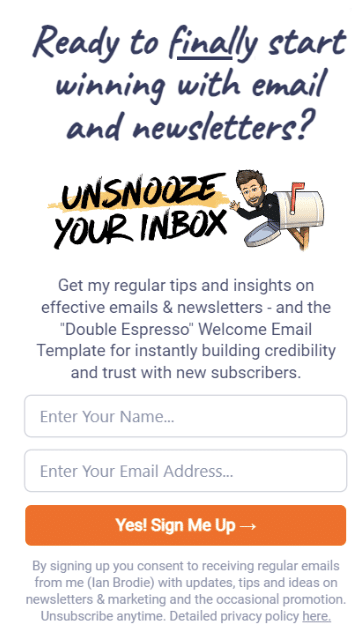As a freelancer, you’re always on the lookout for new growth opportunities. Email might not be a new strategy, but it’s one of your best chances for a steady income stream. It remains a top marketing channel to acquire more clients—and build connections. And it’s affordable, too.
Mastering the art of creating compelling email campaigns is a skill you learn once and keeps rewarding you in the long run. To get you started, we’ll present the basic steps to become a successful freelance email marketer. But first, let’s discuss why email is a profitable channel for freelancers.
Why Freelance Email Marketing?
According to data, 75.4% of consumers prefer to receive promotional messages from businesses via email. If that’s not reason enough to invest in email marketing, here are some extra benefits of choosing freelance email marketing:

Get Weekly Freelance Gigs via Email
Enter your freelancing address and we'll send you a FREE curated list of freelance jobs in your top category every week.
- Low investment in budget and time. For freelancers, time and money are of utmost importance. Most email services offer a free trial to test the waters. You can select which features you need and pick your pricing plan accordingly. They come with automation capabilities, too. With them, you can set specific email sequences once and let them run on autopilot. This frees up time to focus on other aspects of your business.
- Strengthened relations. Email gives you access to customers’ inboxes, a far more personal space than social media platforms where you target broader audiences. Email personalization helps you send tailored messages based on each recipient’s needs, making them feel appreciated.
- Enhanced lead nurturing. One-to-one communication via email gives freelancers a unique opportunity to nurture leads throughout their customer journey. Even if they don’t need your services once they sign up, regular email content keeps you top of mind for future collaboration. For instance, you could create a bi-weekly or monthly newsletter, where you showcase your expertise and provide helpful tips to address their challenges.
A Guide for Freelance Email Marketers: Reaching Success with Email
So, we’ve established why email marketing is ideal to build a successful freelancing career. Now it’s time to go through the steps to make it happen.
Identify your Customer Personas
“Who is the ideal customer persona to target?” That’s the first and most important question to answer before even building an email marketing strategy. The consumer pool is too wide, and targeting many different groups could lead you on the wrong path. You should carefully consider your specific skills and the industry for which they’re a perfect fit.
For instance, a writer with legal experience or legal background will have attention to detail, strong research skills, and analytical thinking. They probably understand legal standards, making it easier to navigate email regulations and ensure their emails stay within legal boundaries. This profile will be ideally suited for law email marketing.
Given this unique skill set, such a professional should research the following customer personas:
- Law firms and legal agencies
- Regulatory agencies
- Financial institutions
- Healthcare providers
Once you decide on your target clients, create a detailed persona profile before you reach out to them. Consider every characteristic that helps you understand their interests, needs, and pain points.

Contacting the client personas who need exactly what you have to offer is the best way to create a sustainable freelance business. For example, you’ll know what type of incentive to include for them to join your email list. Once you acquire these qualified leads, you’ll be on your way to providing exceptional services to their companies. And that’s how they’ll become recurring customers—and refer you to their network.
Pick a Reliable Email Marketing Service
Sending emails from a regular email client like Yahoo or Gmail as a freelance email marketer isn’t a good idea. A dedicated email platform helps you do more than sending emails.
Here’s how such a tool will power up your email marketing efforts:
- Customizable email templates. Save time with premade designs. Using drag-and-drop email builders, you get to create and send beautiful, professionally looking emails even if you don’t have previous design experience.
- Powerful lead generation features. Build your email list by setting up effective sign-up forms and landing pages. First, you get the right people and then, divide them into groups based on common characteristics like demographics or psychographics.
- Healthy list-building. A reliable email service helps freelancers have healthy email lists. Some of the options provided include adding an unsubscribe option to emails, setting up a double opt-in process, and identifying disengaged audience groups.
- Automated emails and series. With email automation, you can send promotional and transactional campaigns to subscribers at the optimal time without handling each email manually. Some of these solutions offer built-in automated workflows that you can tweak as you please. For example, you can add, remove, or merge conditional steps.
- Robust reporting. Email tools come with analytics that let you track key metrics like open and click-through rates, conversions, and unsubscribes. You can monitor your email performance and make the necessary adjustments to optimize results and increase your customers’ email ROI.
Of course, not every email tool is a great fit for freelancers. Here are our top picks to help you start and advance your freelance email marketing journey:
- Moosend is an affordable email marketing automation service ideal for freelancers who start now or are scaling their email marketing and want a simple-to-use tool.
- MailerLite comes with a generous free plan that allows freelancers to perform basic email tasks using easy-to-grasp features and an intuitive interface.
- Brevo is a marketing solution with a user-friendly email editor for freelancers to create easily. Plus, it offers options to target recipients on SMS and WhatsApp.
Build your Email List
When you get things up and running, it’s time to build a subscriber base. First, you should ensure that the people you add to your list have gone through an opt-in process. That way, you’ll have their explicit consent to deliver email marketing campaigns.
The most common way to invite users to join your list is through a sign-up form. How can they access your form? Here are some of the most popular options:
- Get it onto your portfolio website
- Include it in blog posts
- Promote sign-ups on your social media channels
- Ask your existing network to share it via email
Most email service providers have form builders that let you create beautiful forms in minutes—no coding skills required. You just add the fields you need, that would be their name and email address at first. If the platform offers pre-made form templates and customization functionality, use them to match your forms to your branding. Alternatively, you may use the landing page builders incorporated into some ESPs to design an email sign-up landing page.

To encourage visitors to subscribe, it’s better to throw in a lead magnet. What would your target client want? Your lead magnet could be anything from an eBook or report to an online course or template. The key is to offer something that’s valuable to them or showcases your expertise. Then, you’ll have more chances of getting them on your list.
Let’s see an example of an effective lead capturing form:

Share Insightful Email Content
Delivering meaningful email content is paramount to hook your subscribers. For increased engagement, offer value right off the bat. Your audience’s needs always come first, so focus on what you can do for them. Here are some examples:
- Prove the value of your services by sharing customer success stories in the form of testimonials or case studies. Be sure to include numbers and statistics to back up your claims.
- Use your weekly, biweekly, or monthly newsletter to share educational content, such as links to helpful blog posts you have created
- Keep your subscribers informed by notifying them on new services or projects, sudden changes in your niche or business, or must-attend events
- Share exclusive tips that address your audience’s most common pain points and help them reach success
- Highlight important achievements and milestones like acquiring a certificate or reaching a certain number of subscribers
- Inform recipients about upcoming limited-time offers on your services.
Anything goes if it helps you build authority and makes your clients think of you as their go-to resource. Sending useful email content is key to establishing trust and keeping you top of mind until your recipients need your services.
Follow Email Marketing Best Practices
Gaining and maintaining customer trust goes beyond dispatching helpful email content. Adhering to data privacy and protection laws is crucial, too. To be a successful freelancer, you’ll need to know email regulations and comply with their requirements. Some of them include:

- Getting users’ permission to send them emails.
- Adding an unsubscribe option to every email.
- Simplifying the opt-out process and handling unsubscribes quickly.
- Including a valid postal address in your email footer.
- Avoiding misleading information in your email subject lines and copy.
- Identifying promotional emails and advertisements as such.
Building trust involves not only the quality, but also the frequency of your emails. Sticking to a consistent email schedule goes hand in hand with optimized performance. And that’s because subscribers want you to deliver what you promised.
Was it a monthly email? That’s what they’ll be expecting. If you send emails less often, chances are they’ll forget about you. On the other hand, delivering emails once a week could annoy them.
Optimize your Email Performance
Also, remember that your work isn’t done after you hit ‘send.’ Email marketers should be able to monitor and interpret key metrics such as open rates, click-through rates, list growth rates, conversions, etc. You can access such data through your email marketing software’s analytics. Tracking these metrics will tell you which aspects to improve. This data-driven approach helps freelance email marketers evaluate their success and optimize them for maximum impact.
While monitoring reports is important, never neglect the tried-and-true method of hearing it from the horse’s mouth. Stay in touch with your target audience and ask for their feedback on where you could do better.
Add surveys to your emails and social media, perhaps using a small incentive to encourage completion. Even people who choose to unsubscribe are a valuable source of information. Create an unsubscribe page with a short poll asking users why they opted out to identify common reasons and areas for improvement.
You could also reach out to people who fit your ideal customer profile and interview them to understand their likes and challenges
Invest in Networking
Networking is the perfect method to find more clients. So, make sure you collaborate with other freelancers or professionals in your industry. You can do so using several different ways:

- Connecting on social media
- Attending industry events
- Registering to webinars hosted by niche experts
- Following industry blogs and commenting on posts
- Joining online communities
Connecting with other professionals will be useful in expanding your subscriber base. It’ll also help you exchange insights and stay informed about trends and best practices.
Sometimes it’ll get you further, for example landing a hiring opportunity through your existing contacts. Or it could lead to mutually beneficial collaborations. For instance, team up with a designer or content writer to optimize your content and explore new opportunities—depending on your field of expertise.
Start Planning your Freelance Email Marketing Journey
Freelance email marketing requires careful planning, ongoing development, and long-term engagement with your audience. You can start small by sending simpler emails and scale your strategy as you expand your customer base.
Continuous learning is vital if you want to grow as a freelance email marketer. So, ensure you go after relevant certifications to further develop your skills. Also, stay up to date with the latest email marketing trends and technologies to enhance your credibility.
Spying on established brands is also a bulletproof way to optimize your email campaigns. Ensure you study their best emails in search of inspiration.
This approach, along with the steps analyzed here, will help you manage your email marketing effectively. Keep learning, stay informed, and constantly nurture your audience so you can grow your freelance business and improve customer acquisition and retention.
Keep the conversation going...
Over 10,000 of us are having daily conversations over in our free Facebook group and we'd love to see you there. Join us!



